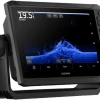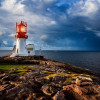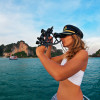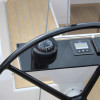Marine Navigation
Learning marine navigation may seem daunting, but actually exists of a few simple skills that can be used throughout your life.
Explore topics
Navigation basics
To learn marine navigation, you only have to be able to do three things:
- Locate your position
- Determine a course
- Monitor the course
In this overview guide, we'll go over all the aspects of marine navigation, and will link to other articles that will explain the different tools and how to use them in more detail. If you know nothing of marine navigation and want to get a comprehensive overview, this is the best article for you.
Types of navigation
There are a lot of different marine navigation methods, instruments, and systems to navigate the seas. In this article, I'll explain most of them, including the navigational instruments that are most used by sailors today.
Compass
Every boat should have a compass and a sailor that knows how to use it. It isn't difficult to use one - it's just so easy to make mistakes if you've never learned to use them. In this post I learn you how.
Charts
Knowing how to use charts is essential, not just as a backup to your chartplotter - which could fail at any time - but also to understand the basics of navigation, giving you valuable insight into the workings of your electronics, and the confidence to go anywhere. Since it is so important, we've created a hub page with lots of resources on the subject.
Chartplotter
Nothing beats the ease of chartplotters when navigating. They do have one important downside, though: they won't provide you with a bearing when not moving. In other words, a chartplotter can't tell you which direction your pointing when stationary, like a compass would be able to. Chartplotters also differ in other ways to for example GPS. You can read everything about them in our dedicated chartplotter hub.
Explore topics
Navigation basics
To learn marine navigation, you only have to be able to do three things:
- Locate your position
- Determine a course
- Monitor the course
In this overview guide, we'll go over all the aspects of marine navigation, and will link to other articles that will explain the different tools and how to use them in more detail. If you know nothing of marine navigation and want to get a comprehensive overview, this is the best article for you.
Types of navigation
There are a lot of different marine navigation methods, instruments, and systems to navigate the seas. In this article, I'll explain most of them, including the navigational instruments that are most used by sailors today.
Compass
Every boat should have a compass and a sailor that knows how to use it. It isn't difficult to use one - it's just so easy to make mistakes if you've never learned to use them. In this post I learn you how.
Charts
Knowing how to use charts is essential, not just as a backup to your chartplotter - which could fail at any time - but also to understand the basics of navigation, giving you valuable insight into the workings of your electronics, and the confidence to go anywhere. Since it is so important, we've created a hub page with lots of resources on the subject.
Chartplotter
Nothing beats the ease of chartplotters when navigating. They do have one important downside, though: they won't provide you with a bearing when not moving. In other words, a chartplotter can't tell you which direction your pointing when stationary, like a compass would be able to. Chartplotters also differ in other ways to for example GPS. You can read everything about them in our dedicated chartplotter hub.



